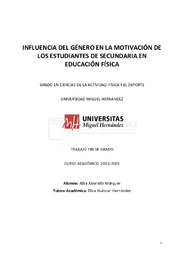Resumen :
El objetivo de este estudio era analizar las publicaciones científicas sobre la influencia del género en la motivación de los estudiantes de secundaria en educación física, con el propósito de identificar los tipos de motivación predominantes entre los alumnos y las alumnas hacia las clases de educación física. Esta revisión bibliográfica se realizó siguiendo la declaración PRISMA 2020 y se llevó a cabo mediante la búsqueda en las bases de datos de PubMed, ResearchGate y Dialnet. Tras revisar los 41 artículos localizados, se descartaron aquellos que no cumplían con los criterios establecidos, resultando un total de 9 estudios seleccionados. Los estudios seleccionados examinaban la motivación de los estudiantes de educación secundaria hacia las clases de educación física, diferenciando entre chicos y chicas. Los resultados indicaron que la mayoría de los estudiantes muestran una motivación autodeterminada, siendo los chicos quienes presentan niveles más altos de motivación intrínseca, mayor satisfacción e interés en comparación con las chicas. En cuanto al resto de tipos de motivación, los resultados fueron variados, lo que impide sacar conclusiones definitivas. A partir de estos resultados, se ha realizado una propuesta de enseñanza destinada a minimizar las diferencias de motivación entre géneros, fomentando la confianza, la cooperación y la igualdad. La conclusión final destaca la necesidad de continuar investigando estas variables, dado que comprender cómo el género influye en la motivación es fundamental para diseñar programas educativos inclusivos que consideren las diferencias individuales y promuevan la participación equitativa de todos los estudiantes.
The objective of this study was to analyze scientific publications on the influence of gender on the motivation of high school students in physical education, with the aim of identifying the predominant types of motivation among male and female students towards physical education classes. This literature review was conducted following the PRISMA 2020 statement and involved searching the PubMed, ResearchGate, and Dialnet databases. After reviewing the 41 located articles, those that did not meet the established criteria were discarded, resulting in a total of 9 selected studies. The selected studies examined the motivation of high school students towards physical education classes, differentiating between boys and girls. The results indicated that most students show self-determined motivation, with boys exhibiting higher levels of intrinsic motivation, greater satisfaction and interest compared to girls. Regarding other the types of motivation, the results were varied, preventing definitive conclusions from being drawn. Based on these results, a teaching proposal has been made to minimize gender differences in motivation by promoting confidence, cooperation and equality. The final conclusion highlights the need to continue investigating these variables, as understanding how gender influences motivation is essential for designing inclusive educational programs that consider individual differences and promote the equitable participation of all students.
|
 La licencia se describe como: Atribución-NonComercial-NoDerivada 4.0 Internacional.
La licencia se describe como: Atribución-NonComercial-NoDerivada 4.0 Internacional.
.png)
